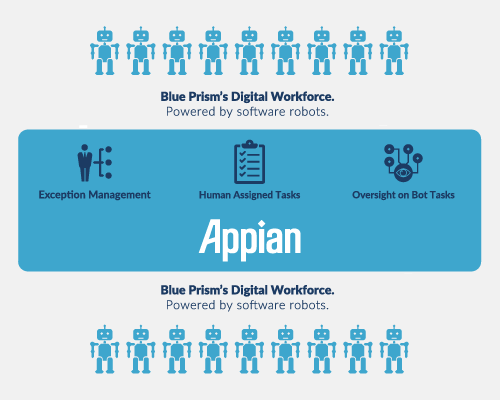In July,Appianannounced its partnership withBlue Prism.This allowsAppian, as the Digital Transformation Platform, to take its enterprise application integration further with legacy IT systems, as well as automate repetitive work.
Blue Prism'svirtual workforce provides a flexible way to work with technologies that have limited-to-no modern integration capabilities.What was previously only possible by a human manually logging into legacy systems and completing an activity can not only now be automated, but the automation can also be exposed forAppianto consume and orchestrate as part of the overall digital transformation journey.

This partnership enhances Appian's integration capabilities to reach into every IT system in your organization.While Appian is used as a strategic digital transformation platform in an organization, Blue Prism can work alongside to provide the tactical advantage in order to automate repetitive activities (such as reading Excel documents or PDFs) and digitize the integration with legacy and black box' IT systems.
How does it work?
InBlue Prism, human interaction with software can be defined in the form of a digital flowchart.When executed, Blue Prism follows and performs defined steps, mimicking the act of a human.This is a powerful feature that can be exploited to work with systems that are otherwise considered black box' (allowing no automated means of integration, such as a COBOL system that has no integration capabilities other than logging into the terminal directly via an emulator).
Appian provides the ability to quickly build powerful enterprise applications through its low-code platform capabilities.Appian also has built-in capabilities to automate work through its Rules Engine combined with straight-through-processing capabilities.Appian can now take this one step forward by calling into Blue Prism to perform areas of activities that can mimic repetitive human activities and improve standardization, governance and auditability.

For the two systems to talk to each other, Appian provides a connector for Blue Prism (available free from the Appian AppMarket) that enables Blue Prism processes to be triggered from within Appian's workflow.The connector also allows for data to be passed into Blue Prism as context for it to perform the necessary work.Users can now add work to the Blue Prism queue and monitor the status of the work directly within Appian.
Integrating the Blue Prism Robotic Process Automation (RPA) metrics along with Appian's Business Process Management (BPM) metrics can open up new areas of improvement within the organization.Appian's analytics & reporting can now slice and dice the data in multiple dimension to provide a deeper insight into the process automation and better understanding of optimizing and managing exceptions.
Exceptions in Blue Prism can be handled by Appian as an actionable activity.This allows for monitoring the performance of exception handling, the frequency and SLA's can be defined by combining the nature of exception along with the details (such as SLA's based on Exception type, Customer type, process type and many more).
To summarize, invest time in leveraging the strengths of the two technologies.If you are an Appian customer, look for areas where Blue Prism RPA can add value to enhance your integration and automate repetitive work.If you are a Blue Prism customer, Appian is the technology to have if you are embarking on an enterprise digital transformation journey. Check out our resource center to learn how the two technologies working together have increased efficiency, decreased complexity and enhanced customer experiences.

This blog post was republished from LinkedIn Pulse.
Appian is a software company that automates business processes. The Appian AI Process Platform includes everything you need to design, automate, and optimize even the most complex processes, from start to finish. The world's most innovative organizations trust Appian to improve their workflows, unify data, and optimize operations—resulting in better growth and superior customer experiences.
- Gartner® Market Guide for Business Process Automation (BPA) Tools 2023
- Gartner® Low-Code Magic Quadrant™ 2023
- Forrester DPA Wave 2023: Digital Process Automation Software
- Gartner® Critical Capabilities for Enterprise Low-Code Application Platforms (LCAP)
- Forrester Total Economic Impact™ (TEI) of Appian 2023 - 95% Faster Processes
- Everest Group PEAK Matrix® - Process Orchestration 2023
- Gartner® Emerging Tech Impact Radar: Hyperautomation 2023
- Appian Ranked by Gartner #1 for Business Workflow Automation with Integration Use Case in Low-Code Report
- Appian named a leader in the 2023 Gartner Magic Quadrant for Enterprise Low-Code Application Platforms
- AON Transforms Reinsurance Claims Processing with Appian
- Appian AI Copilot Delivers Practical Value to Boost Developer Productivity
- Appian Opens New APAC Headquarters in Sydney
- New Appian Platform Democratizes A.I. for Process Automation
- Appian Awarded $2.036 Billion in Lawsuit Against Pegasystems
- Generative AI vs LLMs: What's the Difference?
- AI Process Automation: 4 Predictions for the Age of AI
- Why Data Silos Are Problematic
- Generative AI For Insurance
- Public vs Private AI Explained
- How to Use AI Process Optimization
- Procurement vs Acquisition: What's the Difference?
- 7 Hyperautomation Trends to Watch
- Data Fabric's 5 Key Benefits
- KYC Process: The Complete Guide
- What is a Continuous Improvement Process & How to Implement It
- How to Optimize the Government Procurement Process
- AI/ML Use Cases: 7 Examples to Watch
- How to Align Process Mining w/ Process Automation to Drive Continuous Process Improvement [On-Demand Webinar]
- Eliminate Data Silos with an Integrated Data Fabric [On-Demand Video]
- Creating a Connected Care Enterprise [On-Demand Webinar]
- Transforming Institutional Onboarding [On-Demand Webinar]
- [On-Demand Webinar] Hyperautomation at Hyperspeed